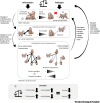Stemming the Flow: Information, Infection, and Social Evolution
- PMID: 32741649
- PMCID: PMC7392855
- DOI: 10.1016/j.tree.2020.07.004
Stemming the Flow: Information, Infection, and Social Evolution
Abstract
Social information and socially transmitted pathogens are governed by social structure, and also shape social interactions. However, information and infection are rarely investigated as interactive factors driving social evolution. We propose exactly such an integrative framework, drawing attention to mechanisms of social phenotypic plasticity for information spread and pathogen control.
Keywords: evolutionary trade-off; network plasticity; social behavior; social decision-making.
Copyright © 2020 Elsevier Ltd. All rights reserved.
Figures



References
-
- Firth J.A. Considering complexity: animal social networks and behavioural contagions. Trends Ecol. Evol. 2020;35:100–104. - PubMed
-
- Kulahci I.G., Quinn J.L. Dynamic relationships between information transmission and social connections. Trends Ecol. Evol. 2019;34:545–554. - PubMed
-
- Stroeymeyt N. Social network plasticity decreases disease transmission in a eusocial insect. Science. 2018;362:941–945. - PubMed
Publication types
MeSH terms
LinkOut - more resources
Full Text Sources

